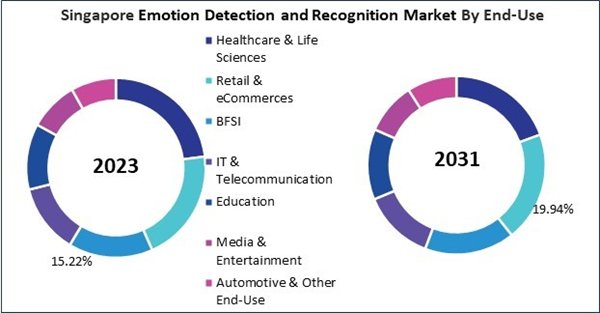The China market dominated the Asia Pacific Emotion Detection and Recognition Market by country in 2023, and is expected to continue to be a dominant market till 2031; thereby, achieving a market value of $13.86 billion by 2031. The Japan market is registering a CAGR of 14.9% during 2024-2031. Additionally, the India market would witness a CAGR of 16.3% during 2024-2031.
The market is expanding rapidly with the integration of emotion-aware technology in smart wearables and IoT devices. Smartwatches, fitness trackers, and AR/VR headsets now use AI-powered emotion recognition to provide real-time feedback on stress levels, mental well-being, and fitness performance. Companies like Apple, Fitbit, and Garmin have introduced biometric sensors that track heart rate variability, electrodermal activity (EDA), and sleep patterns to help users monitor their emotional states. For example, Fitbit Sense’s EDA sensor detects stress responses, while Apple’s Breathe App encourages deep breathing exercises to manage anxiety. In AR/VR, companies like Meta (Oculus), Sony, and HTC are embedding emotion recognition technology to enhance gaming, training, and therapeutic experiences. Meta’s Project Cambria is developing emotion-aware avatars for realistic VR interactions, while Emteq Labs has designed VR headsets for mental health treatments, such as CBT and PTSD therapy, allowing therapists to personalize sessions based on emotional feedback.
Emotion AI is also making its way into IoT-powered smart home devices, transforming how people interact with their environments. Amazon Alexa, Google Assistant, and Apple’s Siri are beginning to incorporate emotion recognition to tailor responses based on a user’s mood. Future smart home systems could detect stress levels through voice and facial analysis and automatically adjust lighting, music, and temperature to enhance relaxation. While these advancements offer exciting possibilities, they also raise privacy concerns, particularly regarding the ethical collection and use of emotional data. Companies must prioritize data security, transparency, and user consent for responsible AI deployment.
In Japan, the healthcare industry presents a major opportunity for emotion detection technology, driven by its advanced medical infrastructure and aging population. The medical devices industry in Japan was valued at $30 billion in 2021, according to the Japan External Trade Organization (JETRO), indicating the growing demand for technologies that enhance patient engagement and streamline healthcare operations. The Health and Medical Strategy of the Japanese government advocates for integrating digital technologies in healthcare, emphasizing the role of emotion detection tools in improving doctor-patient communication, mental health assessments, and elder care services. As healthcare providers seek solutions to combat rising healthcare expenses and guarantee better patient results, emotion detection technology is becoming more and more important in Japan's medical and wellness industries. Consequently, the Asia Pacific region sets the standard for future innovations worldwide by integrating government policies, investment in AI-powered biometric solutions, and a tech-savvy consumer base, ensuring that it remains at the vanguard of global EDR advancements.
List of Key Companies Profiled
- Apple, Inc.
- Amazon Web Services, Inc. (Amazon.com, Inc.)
- Microsoft Corporation
- NEC Corporation
- Thales Group S.A.
- IBM Corporation
- Eyeris Technologies, Inc.
- Cognitec Systems GmbH (Salto Systems, S.L.)
- Realeyes OU
- Smart Eye A/S (Affectiva, Inc.)
Market Report Segmentation
By Tools
- Gesture & Posture Recognition
- Facial Recognition
- Speech & Voice Recognition
By Application
- Surveillance & Monitoring
- Marketing & Advertising
- Robotics & eLearning
- Medical Emergency
- Other Application
By Component
- Software
- Services
By Technology
- Natural Language Processing
- Bio sensors technology
- Machine Learning
- Pattern Recognition
- Feature Extraction
By End-Use
- Healthcare & Life Sciences
- Retail & eCommerces
- BFSI
- IT & Telecommunication
- Education
- Media & Entertainment
- Automotive & Other End-Use
By Country
- China
- Japan
- India
- South Korea
- Singapore
- Malaysia
- Rest of Asia Pacific
Table of Contents
Companies Mentioned
- Apple, Inc.
- Amazon Web Services, Inc. (Amazon.com, Inc.)
- Microsoft Corporation
- NEC Corporation
- Thales Group S.A.
- IBM Corporation
- Eyeris Technologies, Inc.
- Cognitec Systems GmbH (Salto Systems, S.L.)
- Realeyes OU
- Smart Eye A/S (Affectiva, Inc.)
Methodology

LOADING...









